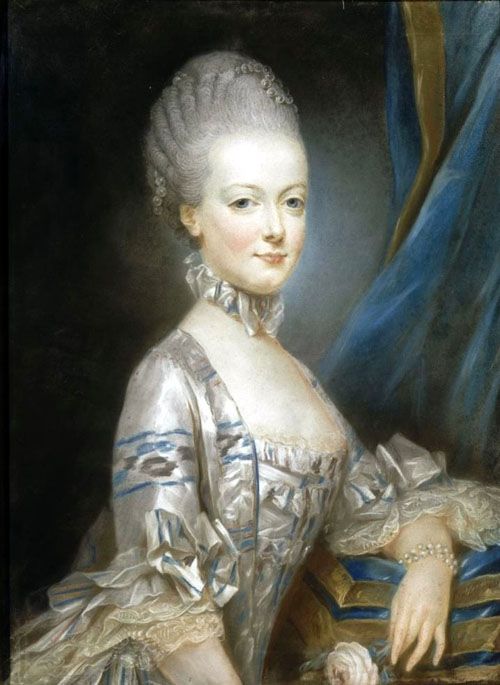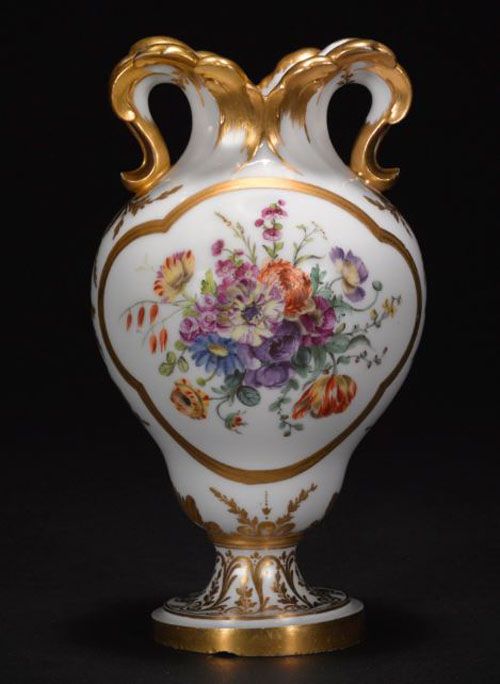PROVENANCE
Delivered to Queen Marie-Antoinette (1755-1793) in 1774, most probably for the Petit Trianon at Versailles ;
Private collection.

LITERATURE
Rosalind Savill, The Wallace Collection, Catalogue of Sèvres Porcelain, London, 1988, Vol. I, p. 146, note 18o.
CATALOGUE NOTE
An Antique subject of the last taste.
The shape of this vase was created by Jean-Claude Duplessis at the Vincennes manufacture in 1754, and became available in several sizes the following year. Unlike other vases of the 1750s, the vase à oreilles does not go out of fashion when the neoclassical taste appears, its variation in biscuit was still present in the 1780’s. On this vase dating from the first hours of hard paste production at Sèvres, the painter and gilder Nicolas Schradre who just arrived at the Sèvres factory, had tempered the rocaille style of the model with a quatrefoil shape for the cartouches, with the symmetry and repeat of the ornaments, and also by choosing a subject from antiquity. The landscape painting of this vase is based on the engraving by Giovanni Battista Piranesi, also known as Piranèse (1720-1778) from 1748 and representing L’Arc de Drusus in Rome, erected near the Porta San Sebastiano on the Via Appia (fig. 3). The composition is enriched by figures and a fortress in the background, however the arch and the inscription on the rectangular cartouche are faithfully transcribed.

The first vase bought by the young Queen Marie-Antoinette in 1774
On 1st January 1774, a precise inventory of the Sèvres factory stock is drawn up in which only one pair of vases à oreilles is listed, described as 2 vases à oreilles, 3e grandeur, paysage riche en or [2 vases à oreilles, third size, landscape, rich gilding], priced 288 livres (fig. 1).1 During the year 1774, Marie-Antoinette, as now young Queen of France, buys her first Sèvres pair of vases : a pair of vases à oreilles at the price of 288 livres (fig. 2).2 No other vases à oreilles are sold this same year at this price and the pair mentioned in the 1774 inventory is no longer in the following stock inventory. Furthermore, the ample and abundant gilding ornaments on the present vase are consistent with the wording riche en or.
During her reign the Queen Marie-Antoinette buys a limited number of vases from Sèvres : five garnitures of three vases, five pairs of vases and two single vases. The two garnitures bought for 3000 livres in 1776 and 1781 appear in the inventory of Marie-Antoinette’s apartments at the château de Saint-Cloud. One of them is composed of three vases œuf, with chinoiserie decoration, from 1775-1776 and now preserved at the château de Versailles (inv. no. V 5225 1-3). The 1781 garniture with a Taillandier pink ground embellished with enamelled ‘jewelled’ decoration is now preserved in the Huntington collection, California.3 In December 1779, the Queen also purchased three gilt-bronze mounted vases for 2400 livres which are today in the British royal collection (The three garnitures are reproduced in the catalogue of the exhibition Marie-Antoinette, Paris, Grand Palais, 15 March - 30 June 2008, pp. 157-158, 205-207).4
Purchased for the Trianon ?
On 15th August 1774, Marie-Antoinette is given the keys to the Petit Trianon by Louis XVI. At a time when the feeling of a quest for a return to nature dominates, the Trianon is a place of pleasure and frivolity where the Queen offers her guests magnificent celebrations in an enchanting rural setting. Following the Queen’s orders, her architect Richard Mique (1728-1794) in 1775 transforms the botanical garden of Louis XV into an Anglo-Chinese garden. Neoclassical constructions such as the octagonal pavilion : The Belvedere built on the top of a hill looking over the small lake and the Temple of Love built in 1778 gave the park an “Antique” aspect. To magnify the entrance to the Royal ground in 1786 Mique built the Porte Saint Antoine, in the form of a triumphal arch. The antique style painted on the vase a oreilles of Marie-Antoinette evokes the picturesque aspect of the Trianon. This unpublished hard-paste porcelain vase was probably housed at Trianon, but in the absence of inventory registers, lost after the French revolution it is not possible to firmly confirm this.

1. Sèvres, Cité de la Céramique, Archives, I 8 - Inventaire du 1er janvier 1774.
2. Sèvres, Cité de la Céramique, Archives, Vy 6 fol. 208
3. Shelley M. Bennett and Carolyn Sargentson (ed.), French Art of the Eighteenth Century at The Huntington, New Haven, 2008, pp. 248-251, no. 98.
4. For the vases œuf garniture and the vases from the British Royal collection see Marie-Laure de Rochebrune et al., La Chine à Versailles, Art et Diplomatie au XVIIIe siècle, exhibition catalogue, Château de Versailles, 2014, pp. 238-241, nos. 84-85

|


